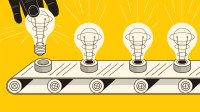
Students constantly experience the effects of different types of energy transformations. They make use of power plants that convert chemical energy into electrical energy every time they plug in their cell phones, for example.
My state is transitioning to the Next Generation Science Standards, which emphasize engineering design and hands-on, student-driven experiences, and I wanted to use that transition to rethink how I teach energy transformation. This project has high school physics students design a conveyor belt to study how energy transfers.
RETHINKING MY UNIT ON ENERGY
One of the easiest ways for students to stop learning is to make a science lab not only one that is no longer fun but also one in which some students cannot participate. My previous lab had students run up and down stairs to calculate their work and power and compare them to their lab partners’ work and power. This demonstrated the formula “work = force x distance.” To do the calculations, students had to share their weight, since that is really the force acting on the person as they climb the stairs.
Many students loved this lab, but others were put off because they were not physically capable of walking or running up the stairs. Others struggled with body image issues, and still others simply did not find the exercise to be relatable. Redesigning this lab gave me an opportunity to think about teaching physics from an equity perspective as well.
THE CONVEYOR BELT LAB
The setup: The new lab introduces students to patents by first looking at the pictures included in the patent for Amazon’s robotic conveyor belt on wheels.
Then students analyze the energy transformations that happen as the conveyor belt moves a package from one part of the belt to the end when it drops the package off into a package chute. This allows students to connect the relationship that work and power have to energy transformations.
As an extension, students are asked to consider the energy transformations of a package traveling from one warehouse to an airplane that goes to another warehouse, and then to a truck that takes the package to the recipient’s house. This part of the energy puzzle allows students to discuss with each other and create energy models on whiteboards that reveal the impact of transporting goods across large distances on the environment and what types of changes to the process might be considered.
Rethinking Energy Transformation Labs
As students actively engage in the lab, they experience productive struggle as they go through the engineering process, where they are often first unsuccessful and then eventually create a working product. Once the students create the conveyor belt, they analyze the work and power of the package as it rises up the conveyor belt’s path.
The outcome:
He is a student who often needs a challenge, so having the challenge of building a conveyor belt with gears that linked together encouraged him to dive deeply into the project.
. One particular student who struggled with the calculations required in physics built a conveyor belt that was the best in her class. She was able to focus on the conceptual aspect of the project, which then allowed her to be proud of herself, and she was more willing to come back to the calculations and work hard to master them. Another student asked, “Since I designed and built this conveyor belt, can I call myself an engineer?” Of course I said, “Yes!”
FUTURE EQUITY IN ENGINEERING-BASED CURRICULUM
When I finally got the idea to have students create the conveyor belt, I realized that not only was it allowing more students to feel comfortable in my classroom, but I was also creating a much more authentic experience for them that aligned with the new standards. Rethinking Energy Transformation Labs My experience with the results that students came up with and the overall impact on student learning means that I will continue to develop these types of experiences for students in the future.
In my class, I often focus on offering students alternative assessments. I have a process for students to show their new understanding after a test that has gone wrong that allows them to show their new understanding in a variety of ways, including hands-on projects, because not everyone shows their understanding best on a multiple-choice test. Physics is a particularly difficult subject for some, and I want everyone to feel comfortable making mistakes and correcting them. For this lab, I emphasize the importance of productive struggle and alternative assessment. In the lab, students can self-differentiate and choose their comfort level when designing and building a conveyor belt.
Amazon is still improving upon the design of the conveyor belt, after all.
